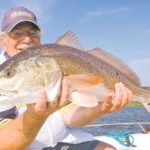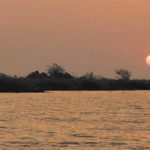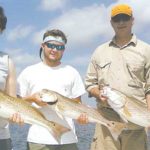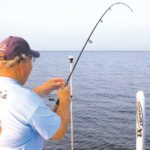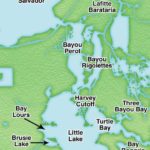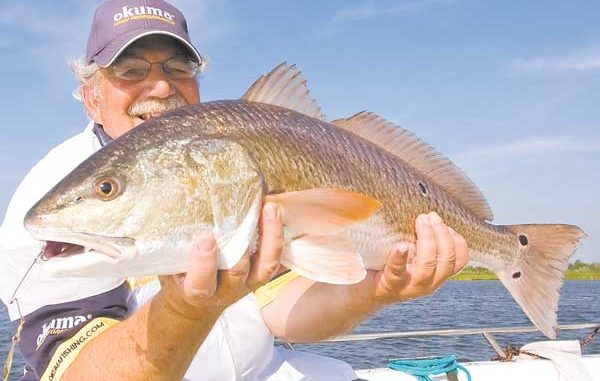
Sure, it’s hotter than a coal snatched from hell’s fireplace, but by the time noon rolls around, you’ll be back in your truck with a limit of Lafitte redfish.
Catching redfish out of Lafitte during the summer is a little like dancing the Cotton-Eyed Joe during dollar-pitcher night. You’ve got to be able to go forward. You’ve got to be able to go backward. And you’ve got to be able to bump into other people without getting knocked off your feet.Papa Joe Bush with Cajun Wetlands Guide Service out of Lafitte has an adjective to describe it.
“You got to be traversable,” he quips. “Move to and fro, cross and recross, go up, down, diagonally, to the side — whatever it takes to catch fish. Traversable. That’s it.”
By the looks of it, we were going to have to be extremely traversable on the day Bush took me out to prove the redfish started schooling in Little Lake just a little bit early this year. Word had spread quickly, and Bush knew we were going to have to contend with a small armada of bay boats and bass boats.
If we wanted to put any reds in the box, we were going to have to bump into other people without getting knocked off our feet. And nowhere was that more evident than our first stop at the main point at the top of Bay L’Ours. Alone at sunrise, boats penned us in on either side before the morning dew had dried.
“Good thing I’ve got us in the best spot because we ain’t going anywhere,” Bush pointed out as we followed a big group of reds pushing toward us from the point. “Get your bait out there right in front of them when they get close enough. They’ll bite. They always do.”
Redfish usually don’t show up in Little Lake until some time around the 4th of July, but this year has been different. For reasons known only to the fish, they began to push around on the banks of Little Lake and Bay L’Ours during early June. Bush feels like the majority of these reds migrate down from Lake Salvador, but the fact that big schools can be found up there throughout the summer makes him a little unsure.
“It’s hard to tell,” Bush said as we resumed fishing after putting the first redfish on ice. “They probably migrate in from all over the place. I don’t guess it really matters where they come from as long as they’re here. And they’re here to get full. You see all these mullet around here? A bunch of little crabs, too. Those reds like bellying up to the buffet.”
As good as our early action was, the reds couldn’t stand the gauntlet for too long, and the action eventually slowed. Since we couldn’t expand our search down the shore because of the other boats, Bush decided we should go look around in nearby Brusle Lake to see if we could spot some tailing reds.
However, we quickly discovered that the fishing pressure wasn’t limited to Little Lake and Bay L’Ours. Every spot Bush wanted to fish already had two or three boats on it, so we continued our search. When he found an empty bank, Bush always idled straight in toward the shoreline rather than run parallel to it.
“If you noticed, I try to come straight in on any bank I think we might fish,” Bush explained. “I don’t like to idle lengthwise on a bank because I might wind up fishing that bank if I see some reds moving. Also, other people might come in and run that same shoreline. I don’t want to mess up the fishing for myself or anybody else, so I go straight in.”
After unsuccessfully fishing a couple different shorelines in Brusle Lake and back out in Bay L’Ours, Bush ran back into Little Lake, and headed to the west. He pointed out that the entire west side of Little Lake would be good throughout the summer except for when the reds start schooling up in the middle.
Although some reds will remain on the bank when that happens, Bush says it’s impossible to pass up all that action out in the middle where redfish will thrash the surface into a whitewater frenzy.
“Everybody talks about working the birds for trout,” he said, “but you can also work the birds to find these giant schools of redfish. They’ll tattle on the reds just like they do the trout. And even though I like Little Lake, you can actually start looking for the schools up in Lake Salvador and work your way down.”
Starting up north, Bush pointed out Lake Salvador, Bayou Perot, Bayou Rigolettes, Little Lake, Bay L’Ours and Plum Point. In fact, Bush explained that had the wind been blowing from the southwest rather than the northwest during our trip, we could have worked the whole bottom shoreline below Plum Point.
We started patrolling a shoreline just north of the Bay L’Ours point, and immediately noticed big wakes pushing around the small patches of vegetation. One redfish in particular showed a little too much right by the boat, and a short pitch with my Saltwater Assassin Red Daddy spinnerbait got the blade turning right in front of its nose.
The 27-inch fish put on quite a show before finally allowing itself to be led into Bush’s waiting net. After unhooking the fish and working on my spinnerbait, I asked Bush if this was what anglers fishing Little Lake could expect to catch through September.
“Normally, when you catch the big schools out in the middle, they’re all big like this,” he said. “Getting your one over 27 is a no-brainer for everybody in the boat. I personally don’t like to keep them this big because they’re not that good to eat, and they’re the ones that are going out and joining the spawning stock pretty fast. I prefer the ones 20 to 25 inches, which there are a lot of, too, but those big ones are really fun to catch.”
Since the action out in the big schools can be so fast and furious, Bush typically keeps only two lures tied on. One is the H&H Coastal Tackle spinner with the stainless steel wire rigged with either a purple/white or black/chartreuse plastic, and the other is the cheapest plastic he can find rigged on a plain jighead without the spinner.
“I like the blade a little earlier in the summer because the reds seem to run a little farther to get your bait then,” Bush explained. “But when they get in the big schools in the middle, I throw something cheap. It doesn’t matter what it is or what color because they’re going to hit it. I keep it cheap because I know we’re going to break some lines and when we get two or three people in the boat all hooked up at the same time, those lines are going to eventually rub into each other, and we’ll loose baits that way, too.”
After finishing up a couple runs on the Little Lake shoreline, Bush decided to go back to where we started to end our day. One of the boats from earlier was still there. In fact, it was still anchored in the same place. Splashing water and a dripping net indicated that they were still catching fish.
There weren’t as many pushing reds this time around, but there were enough to throw at. Bush held his casts for moving water while I started blindly casting all around the boat. We both continued to catch smaller, grilling-sized redfish, but the bite became distinctly different as we approached noon.
Bush explained that schooling reds are generally a lot more aggressive in how they chase a bait early in the morning. The closer to noon you get, the more they’ll just start nosing the bait and not really commit to eating it. Our aggressive strikes became bumps that were followed by nothing more than slack line.
As we stowed our gear for the return trip to his dock, Bush had some final advice to pass along before the wind started buzzing our ears.
“Once all these boats get in here, the fish start busting up a little bit and get harder to catch,” he said. “That’s especially true when they start schooling up in open water. It doesn’t take but one boat out there to come running in on the big motor to make the school go down. Then nobody catches anything.”
You’ve got to get out to Little Lake early for the best action. Considering how all the boats will disperse the redfish schools and the thermometer will start maxing out, there’s really not much reason to fish past 10:30 or so unless you’re still looking for that final fish to fill your limit.
“Stay traversable,” Bush said, “and you won’t even have to look that long.”
Contact Capt. Papa Joe Bush at 504-689-3728. Follow the author’s blog at www.chrisginn.com.
